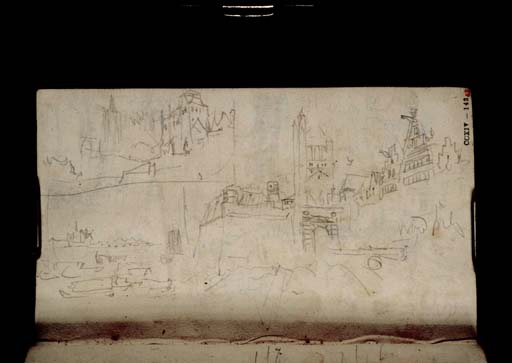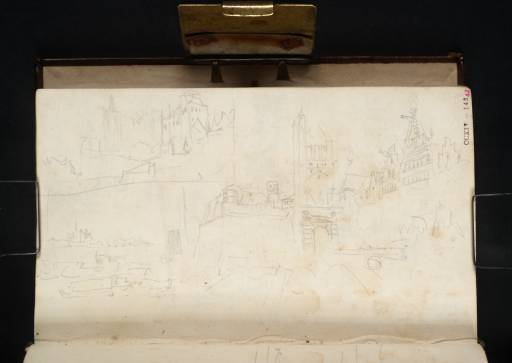Joseph Mallord William Turner Views of the Bollwerk and Great St Martin Church, Cologne, from the Rhine Riverfront near the Kostgassen- or Trankgassentor 1825
Image 1 of 2
-
 Joseph Mallord William Turner, Views of the Bollwerk and Great St Martin Church, Cologne, from the Rhine Riverfront near the Kostgassen- or Trankgassentor 1825
Joseph Mallord William Turner, Views of the Bollwerk and Great St Martin Church, Cologne, from the Rhine Riverfront near the Kostgassen- or Trankgassentor 1825 -
 Joseph Mallord William Turner, Views of the Bollwerk and Great St Martin Church, Cologne, from the Rhine Riverfront near the Kostgassen- or Trankgassentor 1825 (Enhanced image)Enhanced image
Joseph Mallord William Turner, Views of the Bollwerk and Great St Martin Church, Cologne, from the Rhine Riverfront near the Kostgassen- or Trankgassentor 1825 (Enhanced image)Enhanced image
Joseph Mallord William Turner,
Views of the Bollwerk and Great St Martin Church, Cologne, from the Rhine Riverfront near the Kostgassen- or Trankgassentor
1825
Joseph Mallord William Turner 1775–1851
Folio 143 Recto:
Views of the Bollwerk and Great St Martin Church, Cologne, from the Rhine Riverfront near the Kostgassen- or Trankgassentor 1825
D19122
Turner Bequest CCXIV 143
Turner Bequest CCXIV 143
Pencil on white wove paper, 95 x 155 mm
Inscribed by Turner in pencil ‘Wh[?ite]’ towards top left, with line to ‘w’ on building, ‘y’ towards top right, beside tower, and ‘wood pil[?g]’ centre right
Inscribed by John Ruskin in red ink ‘43’ top right, ascending vertically
Stamped in black ‘CCXIV – 143’ top right, ascending vertically
Inscribed by Turner in pencil ‘Wh[?ite]’ towards top left, with line to ‘w’ on building, ‘y’ towards top right, beside tower, and ‘wood pil[?g]’ centre right
Inscribed by John Ruskin in red ink ‘43’ top right, ascending vertically
Stamped in black ‘CCXIV – 143’ top right, ascending vertically
Accepted by the nation as part of the Turner Bequest 1856
Exhibition history
1980
J.M. William Turner: Köln und der Rhein: Aquarelle Zeichnungen Skizzenbücher Stiche, Wallraf-Richartz-Museum, Cologne, October–November 1980 (26, as ‘Groß St. Martin und Rheintor in Köln’, reproduced).
References
1909
A.J. Finberg, A Complete Inventory of the Drawings of the Turner Bequest, London 1909, vol.II, p.656, CCXIV 143, as ‘St. Martin’s, and other buildings, from the river’.
1980
Agnes von der Borch and Gerhard Bott, J.M. William Turner: Köln und der Rhein: Aquarelle Zeichnungen Skizzenbücher Stiche, exhibition catalogue, Wallraf-Richartz-Museum, Cologne 1980, p.70 no.26, as ‘Groß St. Martin und Rheintor in Köln’, reproduced.
1981
Karl Heinz Stader, William Turner und der Rhein, Bonn 1981, p.15 note 34, p.48 note 99.
1984
Martin Butlin and Evelyn Joll, The Paintings of J.M.W. Turner, revised ed., New Haven and London 1984, p.142 under no.232.
1991
Cecilia Powell, Turner’s Rivers of Europe: The Rhine, Meuse and Mosel, exhibition catalogue, Tate Gallery, London 1991, pp.45, 61 note 38, fig.35, as ‘The Rhine gate, Cologne’.
1995
Cecilia Powell, Turner in Germany, exhibition catalogue, Tate Gallery, London 1995, pp.34, 77 note 20, 78 note 23.
With the page turned horizontally, there are two variant sketches here, looking south along the west bank of the River Rhine at Cologne towards the spire and pinnacles of the Great St Martin Church, as identified by Finberg.1 There are two further variants on folio 164 verso (D19165), where the main view is a more detailed reprise of the smaller here. Martin Butlin and Evelyn Joll,2 Karl Heinz Stader3 and Cecilia Powell have linked the present page (with Powell alone mentioning the other) to the large oil painting Cologne, the Arrival of a Packet Boat. Evening, exhibited at the Royal Academy in 1826 (Frick Collection, New York).4
Powell observed that it was ‘based – both in its general plan and some of its specific details – upon recent sketches of that city’ in this sketchbook;5 see also folio 142 verso opposite (D19121),6 a study of moored boats which informed elements of the composition. She noted that ‘they do not, however, include such a detailed depiction of the buildings on the far right as one of Turner’s large sketches of 1817 ([Rhine sketchbook: Tate D12983; Turner Bequest] CLXI 54r) which he must surely have consulted.’7 The tower with the distinctive mansard roof in the foreground of the smaller sketch here is a lost gateway east of Cologne Cathedral (out of sight to the right). It was identified by Butlin and Joll8 as ‘the Kostgassepforte gate’ (or Kostgassentor in some sources) in relation to the painting, where it again appears towards the foreground. Other sources place it immediately north of the Frankenturm, as seen in old engravings, referring to it as the Trankgassentor, Kostgasse and Trankgasse being neighbouring streets between the cathedral and the river.9 It is seen across the Rhine in the contemporary Holland, Rhine and Cologne sketchbook (Tate D19508; Turner Bequest CCXV 65a).
The Frankenturm had been largely demolished in 1823, as noted in the caption inscribed below a detailed 1822 watercolour elevation of the tower by Heinrich Oedenthal (Rheinisches Bildarchiv, Cologne). In Turner’s painting, it rises prominently between the church and the Kostgassen- or Trankgassentor, about where Turner has apparently indicated a ‘White’ element in the smaller variant sketch. The main view on D19165 includes three statues in niches rising just clear of the top of the adjacent walls, corresponding with those shown on the river frontage of the intact tower in Oedenthal’s watercolour. Powell’s supposition about Turner’s referring to D12983, the heavily stained 1817 drawing, while working on the painting is thus evidently correct, not only in terms of the greater detail it furnished but also the range of buildings it shows as they had then stood. Presumably he nevertheless included the picturesque Frankenturm as an echo of the soaring church tower. See also folio 149 recto (D19134) in the present book, which also relates to the central part of the composition.
The ‘wood ‘pil[?g]’ noted below the gables in the main sketch here resulted in a busy woodyard scene being included in the foreground of the painting. In the left distance, Deutz Abbey is seen across the bridge of boats which was then the only crossing; see under folio 154 verso (D19145). Above the bridge, twenty miles or so upstream beyond Bonn, are the undulating Siebengebirge (Seven Hills). Compare the backgrounds of folios 146 verso and 149 verso (D19129, D19135), and the profiles on folio 151 recto (D19138), and see also Tate D19462 (Turner Bequest CCXV 34a) in the Holland, Meuse and Cologne book.
The defensive Rheinmauer walls and most of the remaining towers were demolished later in the nineteenth century. The section towards the church is marked on maps of the time as the Bollwerk, with a large, turreted bastion on a shallow half-hexagon plan jutting out into the river on the near side of the church, as seen at the centre of the main view. Butlin and Joll described the adjacent rusticated Baroque gateway as at ‘the entrance to the Zollstrasse’,10 no longer extant but noted in old guidebooks as leading west to the Alter Markt. It is unclear from earlier maps whether the arch had a specific name; Turner made a written note of various gateways and wharves on folio 140 verso (D19117).
Agnes von der Borch described the subject as ‘Groß St. Martin und Rheintor in Köln’,11 while Powell gave it as ‘The Rhine gate, Cologne’,12 by association with the longstanding title of a watercolour (National Museum Wales, Cardiff)13 from the 1817 series first owned by Turner’s great friend and patron Walter Fawkes (who died in the same autumn as the present tour), which focused on the central elements of the scene developed on a much larger scale in the 1826 work. As Powell has noted, a detailed study of the gateway and its immediate surroundings in the 1817 Waterloo and Rhine sketchbook (Tate D12752; Turner Bequest CLX 27a) was presumably an additional source for the watercolour,14 and it likely informed the oil. Both compositions show evocative evening light from the top right, with strong diagonal shadows, although as usual there are no such indications in any of the sketches; this may be an indication that Turner was thinking in terms of Fawkes, as well as in relation to other elements of the 1826 painting discussed under D19121.
Despite nineteenth-century redevelopment, substantial damage during the Second World War and later bridges, some features of Cologne’s main river prospects, including St Martin’s, remain recognisable, but this one is otherwise totally changed. The walls and gate survived long enough, with further renovations and alterations, to be the subject of a stereoscopic photograph by William England from a similar viewpoint, Tour de l’Eglise St. Martin à Cologne, from an 1867–8 series of Views of the Rhine and its Vicinity / Der Rhein und seine Umgebungen.15 Compare also an 1833 engraving of the scene under a stormy sky after Turner’s friend and rival Clarkson Stanfield,16 and a sunnier colour lithograph in Stanfield’s Sketches on the Moselle, the Rhine & the Meuse of 1838.
See under folio 141 recto (D19118) for discussion of Turner’s views of the city in 1825 and on other occasions.17 The wider significance of the 1826 painting, which would prove the only substantive outcome of the present journey, possibly to fulfil a commission which may have been its primary motivation, is discussed in the Introduction to this sketchbook.
Matthew Imms
September 2020
See Martin Butlin and Evelyn Joll, The Paintings of J.M.W. Turner, revised ed., New Haven and London 1984, p.142.
See notes and paintings reconstructing various fortifications lined to interactive map of ‘Köln – Große Stadtmauer 1180 bis 1881’, Siegfried Glos, Das alte Köln, accessed 17 June 2020, https://www.das-alte-koeln.de/online-fuhrung.html .
One of various subjects from the series in the Rijksmuseum, Amsterdam, Rijksmuseum, accessed 23 June 2020, https://www.rijksmuseum.nl/nl/collectie/RP-F-F13650 .
How to cite
Matthew Imms, ‘Views of the Bollwerk and Great St Martin Church, Cologne, from the Rhine Riverfront near the Kostgassen- or Trankgassentor 1825 by Joseph Mallord William Turner’, catalogue entry, September 2020, in David Blayney Brown (ed.), J.M.W. Turner: Sketchbooks, Drawings and Watercolours, Tate Research Publication, March 2023, https://www

